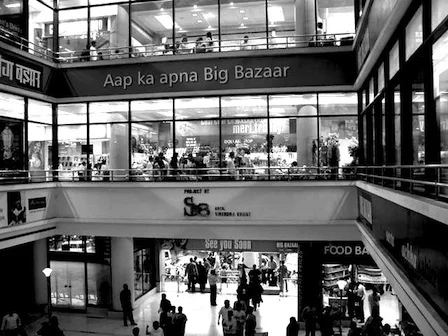Indian Malls: Collective Self-Expression on the Global Canvas
To best understand India, take a meandering walk through an Indian mall. In 1999 my house in Gurgaon featured a village next door and a long drive into Delhi. A decade later, a new patchwork has taken root. The mall may be an ancient innovation, but was perfected in egalitarian, laissez-faire free-for-all, America. Bright, attractive stores displaying pinnacle technology and fashion through wall-to-ceiling glass; air-conditioning; dinner, dessert, a movie, and parking space.
To the upper class malls are a convenience long over due. Foreign exposed, they glide through this temple making subliminal comparisons between malls here and malls there. Small things are noticed—quality of the workmanship, aspirational architecture that falls flat, an overly ornate tap in a musty bathroom. Many flit straight through the maze into their Gold Class movie seats, with four times the space and a ticket price to match.
The lower class, drawn to cities for unskilled salary, come from communities where the largest structure is a government cell phone tower or state bus depot. The intense capital density of a mall can boggle the mind, attempting to comprehend the invisible hand that organized it. Though the mall is a pleasant and convenient marketplace, many of these people will never earn enough to sincerely participate. Young men walk shyly through the commercial boulevards, holding hands with each other.
The aspirational class. India shining. Young, bright, ambitious, upwardly mobile, working for the right “corporate” and suddenly flush with more money than their parents could have dreamed of. Many considered purchasing tickets to see India’s first F1 race in Mumbai. Comfortable with English, swaggering with Hindi, it is a pleasure to watch social mobility in action. The growing clout of ancient Indian tradition, which stretches unbroken into murky prehistory, is expressing its collective creative identity on the global canvas through patronage of these FMCG paradises.
Some Indians shake their heads at the apparent Americanization of India. Such people are generally above the age of forty and unable to appreciate the better lifestyle or eco-system a mall represents. Finally Indians are able to trade their labor for competitively organized capital in a climate-controlled environment. Some Indians refuse to shop anywhere else to keep their shoes clean. Adolf Hitler observed of Vienna one hundred years ago:
The ditch which separates [the bourgeois class], which is by no means economically well-off, from the manual laboring class is often deeper than people think. The reason for this division, which we may almost call enmity, lies in the fear that dominates a social group which has only just risen above the level of the manual laborer—a fear lest it may fall back into its old condition or at least be classed with the laborer.
Once as a child I played “shop-keeper, shop-keeper” with my sister. The transaction required me to tie a rubber band around my index finger. As the constricted finger turned blanche white I exclaimed, “I’ve always wanted to be white!”
Colonialism happened, and its effect on the psychology of descendants cannot be predicted. The trek to self-assurance is a perilous one for all peoples. In India people either despise the West or emulate it, but this represents only one facet of 1.2 billion personalities. The dreams of the past finally take flight in where, how and on what all these people apply their capital. Many things you will find at the Indian mall, but certainly not what you were expecting.











